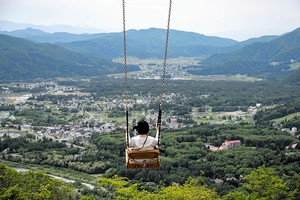By LISA VOGT/ Special to Asahi Weekly
March 19, 2024 at 08:00 JST
That gorgeous color! Upon seeing Kasuga Taisha shrine for the first time, what jumps out, I believe, is that trademark brilliant vermilion: the cloisters, railings, pillars, gates--all dashing "shuiro" next to clean chalk-white walls.
This shade of red, ubiquitous in Japan as the color of many torii gates and "inkan" name seal ink, possesses power and lets people know that for whatever that color is used, it is significant and commands respect.
Vermilion paint is made from cinnabar or mercury sulfide (that’s HgS for you scientists out there). Perhaps younger readers have only seen digital versions, but there was a time when thermometers contained a liquid mercury that rose and fell depending on the temperature under your armpit to gauge if you were running a fever.
This mercury was used for pigment because it preserved wood from the elements and prevented mold. So shuiro keeping things sacred and protected from undesirables makes sense.
Kasuga Taisha shrine was founded in 768 by the Fujiwara clan when Nara was the capital of Japan. Legend has it that a deity rode a flying deer (Rudolph? Oh, deer. I mean, dear. Sorry, I couldn’t resist.) all the way from Ibaraki Prefecture and descended upon Mount Mikasa, a holy mountain east of the shrine sometimes called Kasugayama, to safeguard the ancient capital.
Thus, deer are messengers from the gods and are cherished and protected here. Hunting and felling in the Kasugayama Primeval Forest have been prohibited for more than a thousand years.
Only special Shinto services, "shinji," attended by priests, take place in the sacred forest.
The shrine, a UNESCO World Heritage site since 1998, is also famous for the more than 3,000 bronze and stone lanterns neatly lined up in rows.
They were donated by wealthy merchants, big-name samurai and daimyo feudal lords, and less well-to-do devotees who pooled their money to pay for lanterns in the hopes that guiding lights would illuminate them toward an honorable path and save them from darkness.
Twice a year, all the lanterns are lit up for the Mantoro lantern festival: on Feb. 3 for Setsubun Mantoro and Aug. 14-15 for Chugen Mantoro.
Experiencing the enchanting spectacle of more than 3,000 candles flickering inside lanterns is magical, even if the event is teeming with people. I wonder how long and how many people it takes to light so many candles simultaneously.
Bow. Clap, clap. Bow again.
* * *
This article by Lisa Vogt, a Washington-born and Tokyo-based photographer, originally appeared in the Jan. 21 issue of Asahi Weekly. It is part of the series "Lisa’s UNESCO World Heritage Sites in Japan," which depicts various sites of outstanding universal value across the country through the perspective of the author, a professor at Aoyama Gakuin University.




















A peek through the music industry’s curtain at the producers who harnessed social media to help their idols go global.
A series based on diplomatic documents declassified by Japan’s Foreign Ministry
Here is a collection of first-hand accounts by “hibakusha” atomic bomb survivors.
Cooking experts, chefs and others involved in the field of food introduce their special recipes intertwined with their paths in life.
A series about Japanese-Americans and their memories of World War II